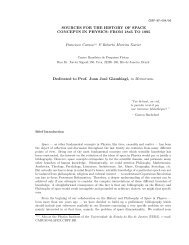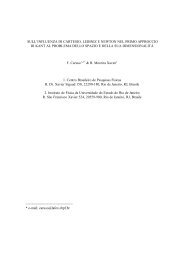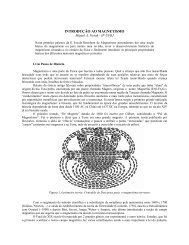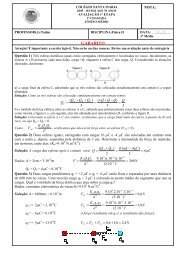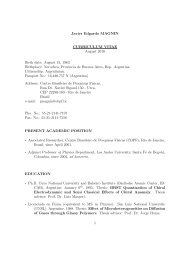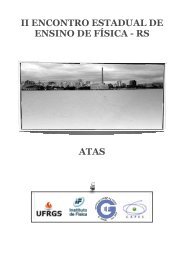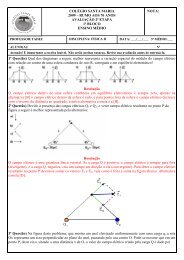Primordial non-Gaussianity in the cosmological perturbations - CBPF
Primordial non-Gaussianity in the cosmological perturbations - CBPF
Primordial non-Gaussianity in the cosmological perturbations - CBPF
Create successful ePaper yourself
Turn your PDF publications into a flip-book with our unique Google optimized e-Paper software.
where V ′ (φ) = (dV (φ)/dφ). Note, <strong>in</strong> particular, <strong>the</strong> appearance of <strong>the</strong> friction term 3H ˙ φ: a scalar<br />
field roll<strong>in</strong>g down its potential suffers a friction due to <strong>the</strong> expansion of <strong>the</strong> universe.<br />
We can write <strong>the</strong> energy-momentum tensor of <strong>the</strong> scalar field<br />
Tµν = ∂µφ∂νφ − gµν L.<br />
The correspond<strong>in</strong>g energy density ρφ and pressure density Pφ are<br />
T00 = ρφ = ˙ φ2 2<br />
Tii = Pφ = ˙ φ2 2<br />
(∇φ)2<br />
+ V (φ) + , (175)<br />
2a2 (∇φ)2<br />
− V (φ) − . (176)<br />
6a2 Notice that, if <strong>the</strong> gradient term were dom<strong>in</strong>ant, we would obta<strong>in</strong> Pφ = −ρφ/3, not enough to drive<br />
<strong>in</strong>flation. We can now split <strong>the</strong> <strong>in</strong>flaton field <strong>in</strong><br />
φ(t) = φ0(t) + δφ(x, t),<br />
where φ0 is <strong>the</strong> ‘classical’ (<strong>in</strong>f<strong>in</strong>ite wavelength) field, that is <strong>the</strong> expectation value of <strong>the</strong> <strong>in</strong>flaton field<br />
on <strong>the</strong> <strong>in</strong>itial isotropic and homogeneous state, while δφ(x, t) represents <strong>the</strong> quantum fluctuations<br />
around φ0. as for now, we will be only concerned with <strong>the</strong> evolution of <strong>the</strong> classical field φ0. This<br />
separation is justified by <strong>the</strong> fact that quantum fluctuations are much smaller than <strong>the</strong> classical<br />
value and <strong>the</strong>refore negligible when look<strong>in</strong>g at <strong>the</strong> classical evolution. To not be overwhelmed by<br />
<strong>the</strong> notation, we will keep <strong>in</strong>dicat<strong>in</strong>g from now on <strong>the</strong> classical value of <strong>the</strong> <strong>in</strong>flaton field by φ. The<br />
energy-momentum tensor becomes<br />
If<br />
we obta<strong>in</strong> <strong>the</strong> follow<strong>in</strong>g condition<br />
T00 = ρφ = ˙ 2<br />
φ0<br />
2 + V (φ0) (177)<br />
Tii = Pφ = ˙ φ 2 0<br />
2 − V (φ0). (178)<br />
V (φ0) ≫ ˙ φ 2 0<br />
Pφ −ρφ<br />
From this simple calculation, we realize that a scalar field whose energy is dom<strong>in</strong>ant <strong>in</strong> <strong>the</strong> universe<br />
and whose potential energy dom<strong>in</strong>ates over <strong>the</strong> k<strong>in</strong>etic term gives <strong>in</strong>flation! Inflation is driven by<br />
<strong>the</strong> vacuum energy of <strong>the</strong> <strong>in</strong>flaton field.<br />
6.5 Slow-roll conditions<br />
Let us now quantify better under which circumstances a scalar field may give rise to a period of<br />
<strong>in</strong>flation. The equation of motion of <strong>the</strong> field is<br />
˙φ0 + 3H ˙ φ0 + V ′ (φ0) = 0 (179)<br />
50




